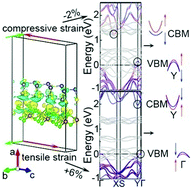Tunable electronic structure and magnetic anisotropy of two dimensional van der Waals GeS/FeCl2 multiferroic heterostructures
Abstract
Two dimensional (2D) van der Waals (vdW) multiferroic heterostructures have potential applications in novel low-dimensional spintronic devices. However, few results on 2D vdW multiferroic heterostructures are reported. Here, the electronic structure and magnetic anisotropy of 2D vdW multiferroic GeS/FeCl2 heterostructures are investigated systematically by first-principles calculations. Spin splitting appears at the conduction band minimum (CBM) and valence band maximum (VBM) of GeS owing to the coupling between S pz, Ge py and Cl px, Fe dxz states in the spin-down channel. The spin splitting is 40 meV at the CBM and 15 meV at the VBM, which can be tailored by biaxial strain. Moreover, at a compressive strain of −2% and a tensile strain of 4%, the spin splitting direction can be inversed at the CBM and VBM. Additionally, the tensile strain makes the system transit from an Ohmic contact to a Schottky one. The vertical strain can alter the interaction between the GeS and FeCl2 monolayers by modulating the interlayer distance. The spatial spin polarization suggests spin-polarized states, which are important in spintronic devices. The compressive biaxial strain increases the magnetic anisotropy energy of the heterostructures, where in-plane magnetic anisotropy appears at different biaxial strains. Their tunable electronic structure and magnetic anisotropy suggest that the 2D multiferroic GeS/FeCl2 vdW heterostructures have potential applications in spintronic devices.



 Please wait while we load your content...
Please wait while we load your content...